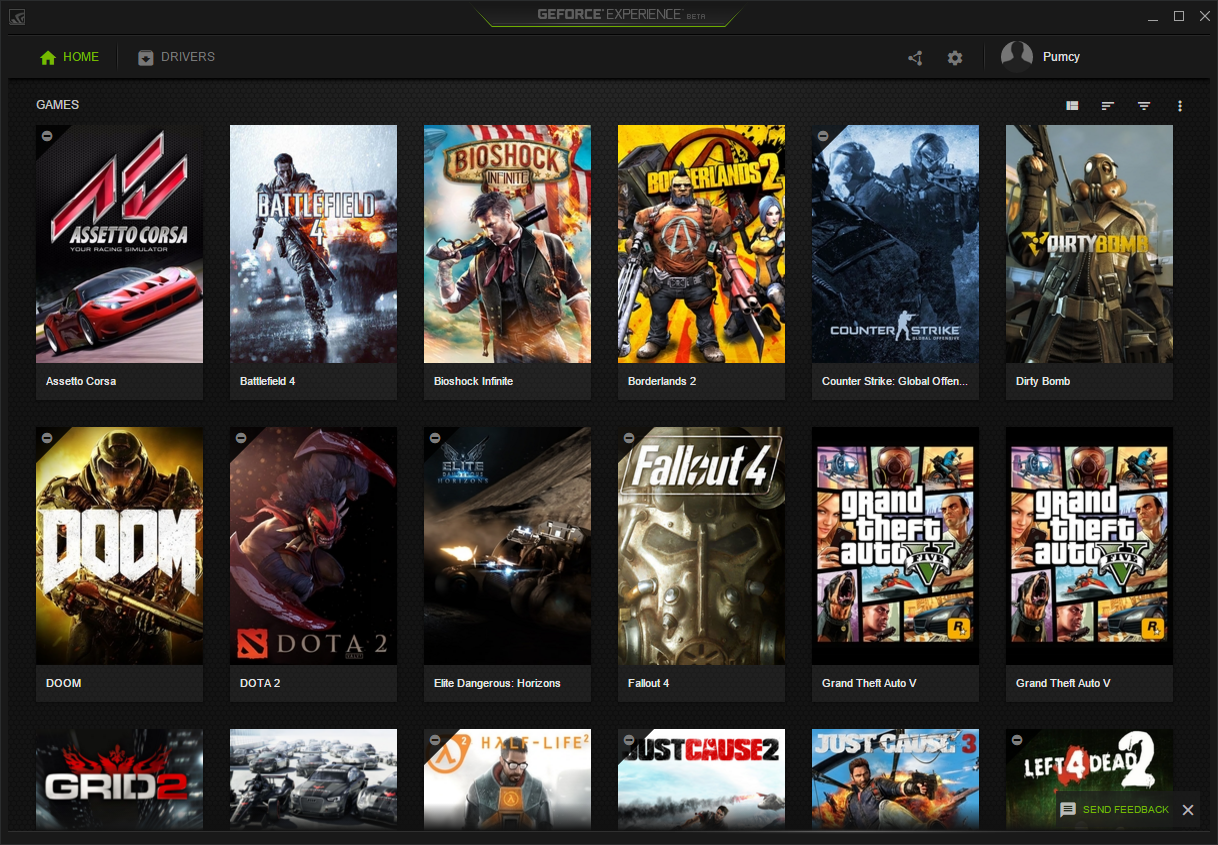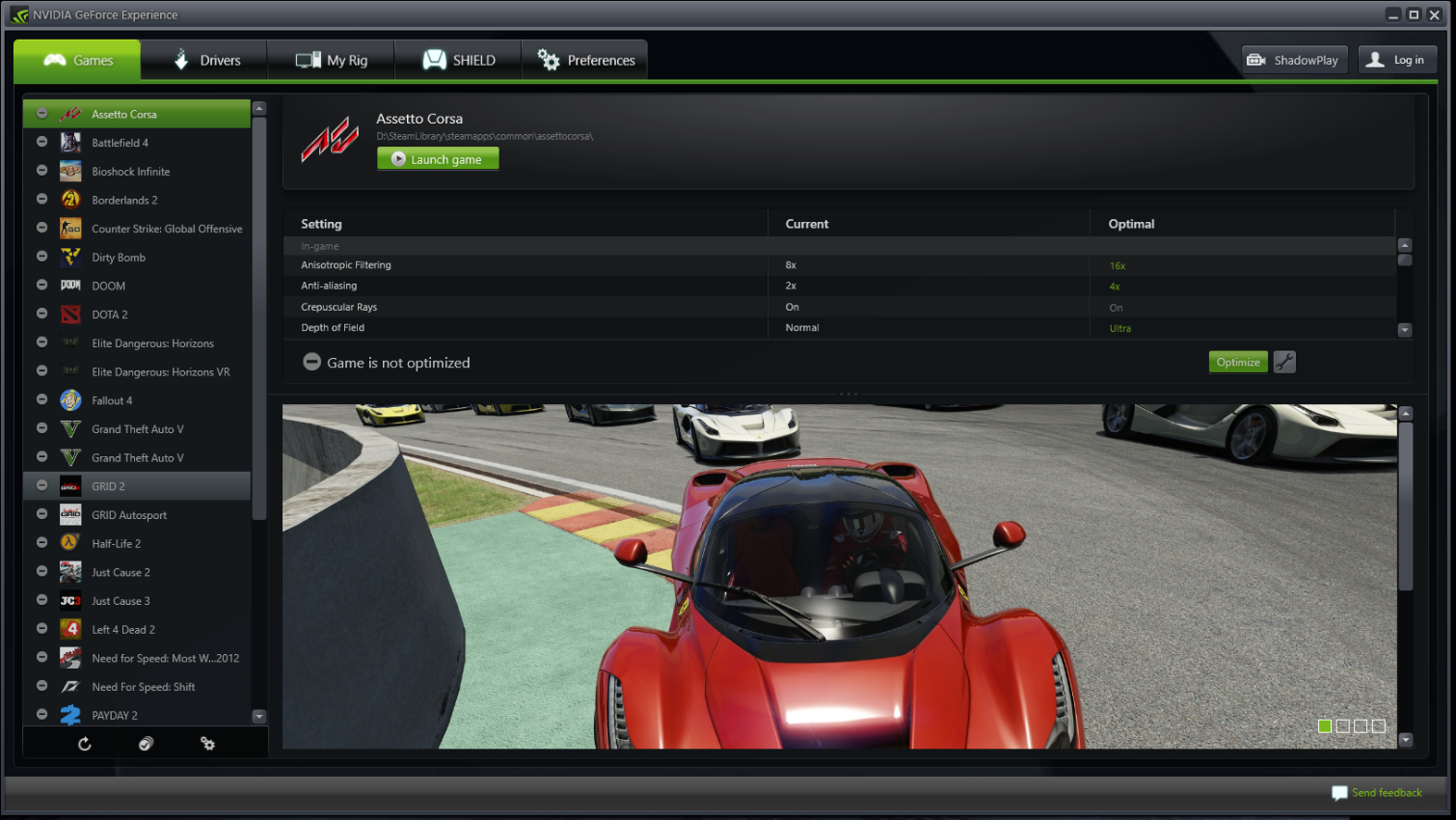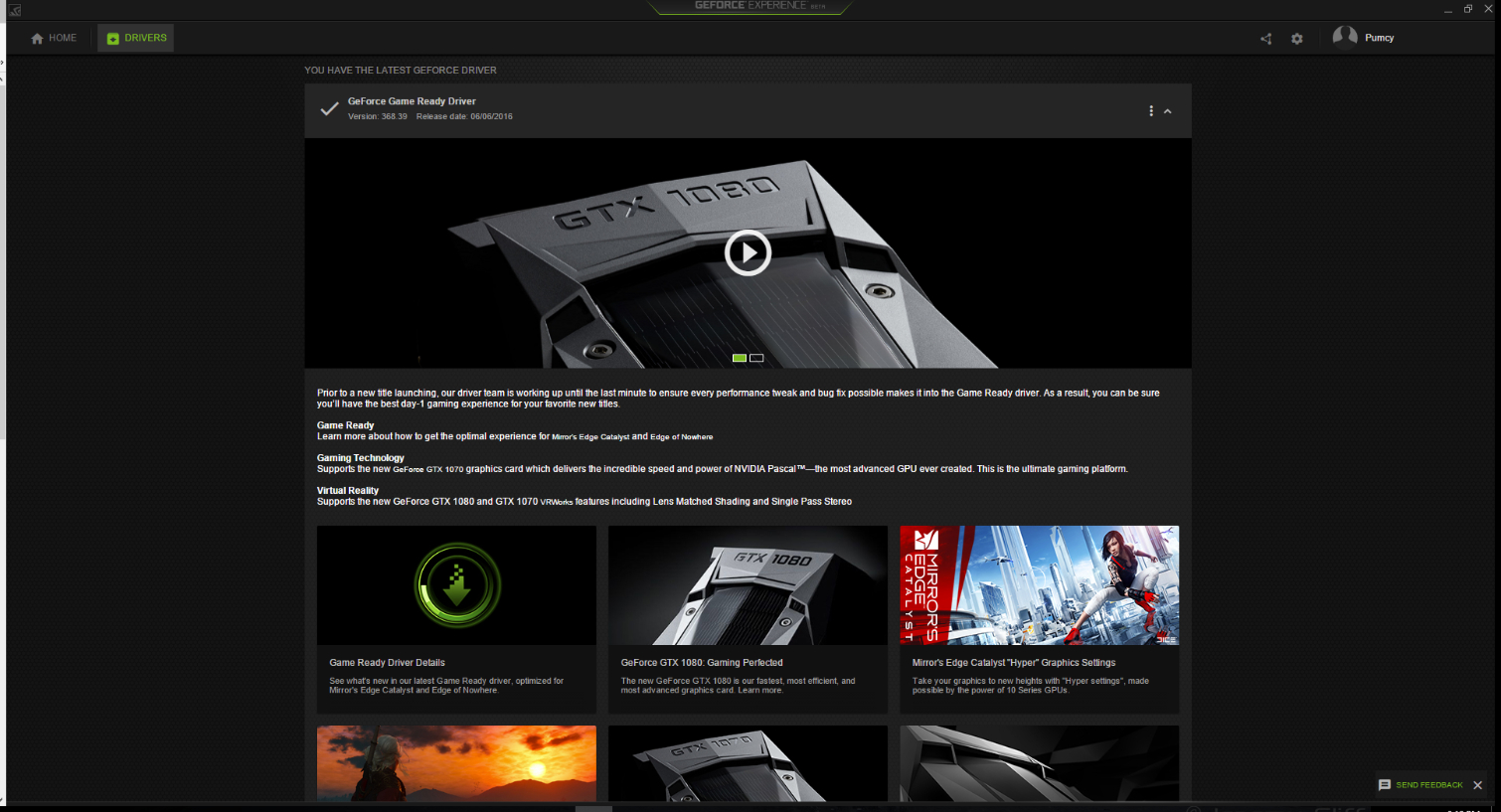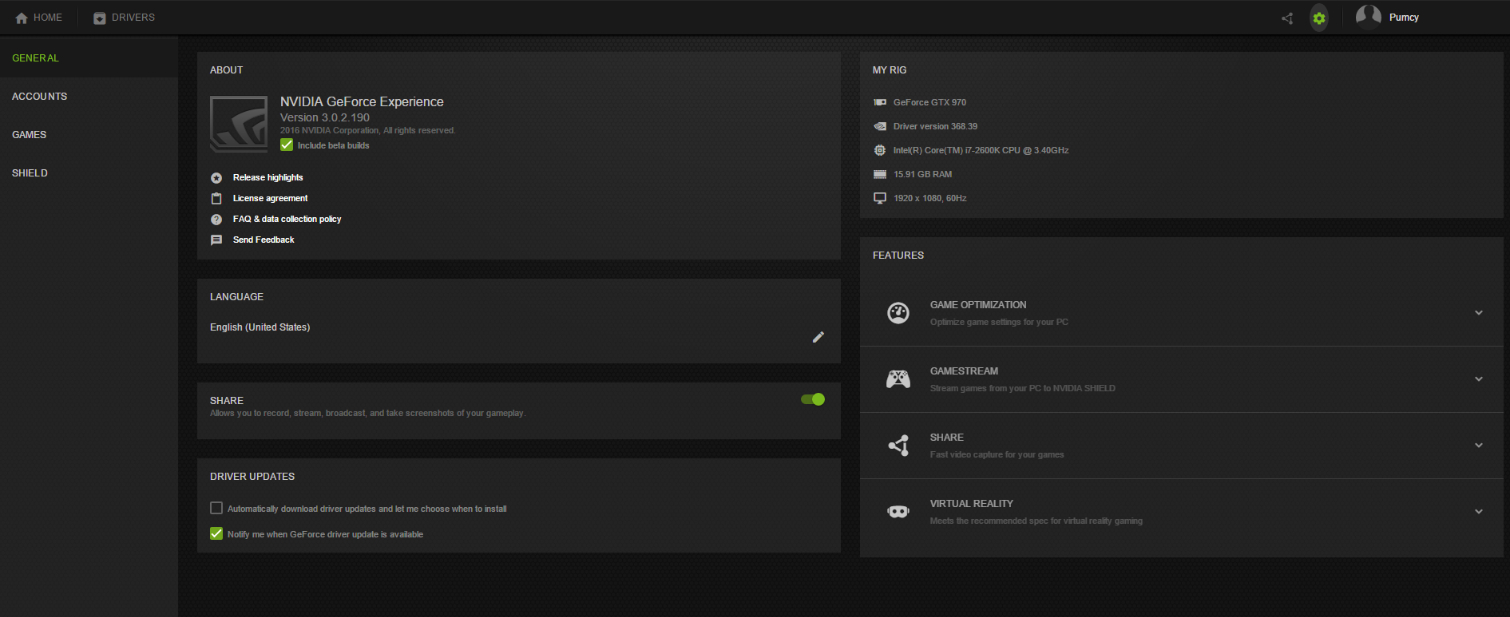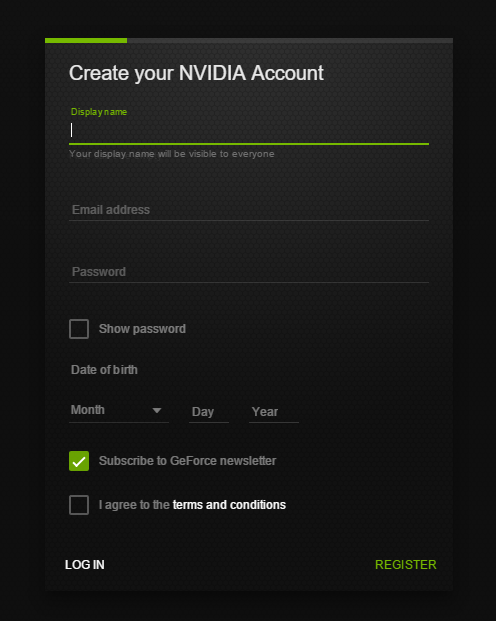Nvidia’s GeForce Experience Beta Gets Significant UI Overhaul, Now Requires Login
Nvidia released a new beta version of the company’s GPU companion application, GeForce Experience. The new version has received a dramatic visual overhaul that makes navigating the software a little bit easier.
GeForce Experience isn’t new, Nvidia first revealed the cloud-based optimization software for game settings in April 2012, and it launched the first beta that following summer. The software has been updated various times throughout its life as Nvidia added features such as ShadowPlay, direct integration into game streaming services such as Twitch and YouTube Gaming, as well as Co-operative Gamestream (which lets you play local multiplayer games with friends over the internet).
In its four-year existence, Nvidia has never really changed the GeForce Experience user interface. The software has evolved to adapt to the new features, but the core appearance and the way you navigate the software has always been the same. Until now.
Nvidia released a beta version of the GeForce Experience software today that changes the look and feel of the application and makes it more of a visual UI, as opposed to text-based. The traditional GeForce Experience layout features a list of pages at the top, including Games, Drivers, My Rig, Shield, and Preferences. The left-hand side of the Games page features a list of all of the games that you own. As you select each game the details of its current and optimal settings, and an example of the visual quality of the game with the current settings, is visible. The UI of the beta version is simplified and easier to navigate.
The Home pane features box art images of all of the games that you have installed on your computer. When you hover over each image, buttons to launch the game and see the current setting details appear. The details page is similar to the previous iteration. The only real change is that the preview image is now above the settings. In the older version, the image was below.
You will also find a Drivers tab next to the Home tab. The drivers page is setup similar to the GeForce.com webpage. It is more of an advertisement and news page than it is a driver details page. One of the driver links within that page is indeed the drivers detail page, and it definitely goes into detail. Not only does it tell you the version of the driver you are running, it also displays details about the GPUs that Nvidia designed that particular driver for, and which games it is “Game Ready” for.
You’ll find the setting page and the shared overlay button on the upper right side of the top pane. Nvidia consolidated several of the options that had their own tabs in the older version of the settings page. Here you’ll find general details about GeForce Experience and your computer hardware. This screen is where you will find the toggle that enables sharing and the check boxes that enable the beta driver, as well as GeForce Experience updates. The settings page is also where you manage your Shield device streaming access (if you have a Shield), as well as which folders GeForce Experience should search for supported games.
Get Tom's Hardware's best news and in-depth reviews, straight to your inbox.
You’ll also notice that there is an account tab inside the settings page, as well as a user account button on the main GeForce Experience window. The new update actually requires you to log in. You have the option to use your Google credentials, which will link your GeForce Experience account to your Google social presence, or you can choose to create a GeForce Experience account. Either way, you will have to log in before you can use the software. The account creation process actually happens the first time you launch the app after the update, and there doesn’t appear to be a way around it.
The update to GeForce Experience is easy to navigate and is definitely a visual improvement, but the fact that you have to log in to use the software might rub some people the wrong way. You can still get your drivers anonymously by downloading them directly from the Nvidia’s website, but you’ll miss out on all the performance optimizations and the game streaming features if you don’t use GeForce Experience.
Follow Kevin Carbotte @pumcypuhoy. Follow us on Facebook, Google+, RSS, Twitter and YouTube.
Kevin Carbotte is a contributing writer for Tom's Hardware who primarily covers VR and AR hardware. He has been writing for us for more than four years.
-
-Fran- Can you elaborate on the "you will miss out on the performance optimizations", please?Reply
It does rub me the wrong way they are now requiring a damn account.
As long as they don't put specific driver optimizations behind that "create an account" thing, I will just opt out.
Cheers! -
kcarbotte Reply18211173 said:Can you elaborate on the "you will miss out on the performance optimizations", please?
It does rub me the wrong way they are now requiring a damn account.
As long as they don't put specific driver optimizations behind that "create an account" thing, I will just opt out.
Cheers!
You can certainly spend the time to adjust your graphics settings manually. GeForce Experience offers a hassle-free way to set your games up with the "best" theoretical performance settings.
It is by no means necessaary. -
tiagoluz8 Reply18211173 said:Can you elaborate on the "you will miss out on the performance optimizations", please?
It does rub me the wrong way they are now requiring a damn account.
As long as they don't put specific driver optimizations behind that "create an account" thing, I will just opt out.
Cheers!
GeForce Experience sets game preferences based on your hardware. You don't need to fiddle with settings to get the best performance out of your GPU, NVIDIA takes care of that. It doesn't support all games, but those that I tested it worked fine, good FPS and decent detail settings. -
-Fran- Ah, thanks for the replies.Reply
I won't create an account for nanny features and more bloat running, haha.
Cheers! -
Karadjgne Every game has detail settings, even if it's nothing more than high/low/ultra. But that's the game itself. GeForce Experience has hardware settings for your games that go above and beyond anything the games software has. It'll allow you to turn down shadows sharpness at specific viewing ranges, shadows density, viewing distance before things get blurry etc. This can be a major asset to ppl with slightly weaker cpus who might otherwise struggle with some fps at the detail settings they desire, but don't care if things like shadows aren't quite as dark or being able to see every blade of grass to the horizon. GE also allows things like rendering at a higher resolution on the hardware side, before it goes to monitor. This can make for very crisp and clear pictures on a lower resolution monitor. That's if the gpu is strong enough during any particular game. It's a simple 1 click optimization where GE determines the optimal settings for best visual and playability results. Of course, these results can also be manually tailored to suit a particular users wants.Reply
I'd rather GE tell me optimum settings on Witcher 3 are medium and get smooth game play than be stubborn and set ultra manually, all the while complaining about only getting 20fps. -
-Fran- Reply18211409 said:Every game has detail settings, even if it's nothing more than high/low/ultra. But that's the game itself. GeForce Experience has hardware settings for your games that go above and beyond anything the games software has. It'll allow you to turn down shadows sharpness at specific viewing ranges, shadows density, viewing distance before things get blurry etc. This can be a major asset to ppl with slightly weaker cpus who might otherwise struggle with some fps at the detail settings they desire, but don't care if things like shadows aren't quite as dark or being able to see every blade of grass to the horizon. GE also allows things like rendering at a higher resolution on the hardware side, before it goes to monitor. This can make for very crisp and clear pictures on a lower resolution monitor. That's if the gpu is strong enough during any particular game. It's a simple 1 click optimization where GE determines the optimal settings for best visual and playability results. Of course, these results can also be manually tailored to suit a particular users wants.
I'd rather GE tell me optimum settings on Witcher 3 are medium and get smooth game play than be stubborn and set ultra manually, all the while complaining about only getting 20fps.
So, from what you're telling me, they intercept the API calls from the games and do their own stuff... Why isn't that in the driver instead? Why do they need something additional that requires an account for it?
I can get a lot of information for a game using nVidia inspector already and set up deep customization options for pretty much any game in the driver. I tried out GFE and it did nothing to help me get better FPS'es so I just did it manually like always.
You're not convincing me, but putting me off.
Cheers! -
Myrmidonas The necessity of account creation/login is very dissapointing. I will pass. After all I can adjust the my games' video settings very well. After all, on many of my games current settigns are not the same as nVidia's optimized ones. I have personal taste and it is different.Reply -
clonazepam The assumption here, and its a reasonable one, is that when you buy their product, you want to have all of the features it offers. That includes the software package. It's not for everyone and it isn't required.Reply
Annoyances with GE over the years are things like using it to optimize a game, then playing it and changing settings yourself later, only to find that GE changes them back again at a later time (if it is specifically set to optimize automatically).
Scanning for all of the games present on the system upon launch can cause the program to take forever to load up. The bulk of my library is on traditional hard drives, so I feel it.
I already had a login since I participate on the geforce.com forums. It's handy for the latest information on driver details / bugs / driver hotfixes, etc. The login's needed to be able to actually post what bugs you might encounter, rather than simply lurking and reading about it.
You also need the login if you intend to share your gaming experience with others. That's done in multiple ways like broadcasting to twitch, youtube, etc, and linking to the accounts on those sites. It just makes sense to have that broadcasting information protected behind a username and password.
Speculating here, if you are a content creator of any kind, especially with the new software available with the Pascal line, having that original work linked back to the creator through username / password is especially handy. In this case, you want there to be meta data that links you back to the originals.
I have nearly everything in GE disabled, it doesn't doesn't scan for games daily, it doesn't optimize any, it doesn't automatically download driver or GE updates, it simply records 20 minutes of gameplay at the highest quality, continuously for my convenience.
tl;dr - I dont have a problem with logging in because I already had a geforce.com username. -
Myrmidonas Ok I see your point. But then again....everyone asks us to create an account and login with it.Then they monitor us.Then some one else hacks our accounts massively, stealing from their databases. This account thing has to stop at some point.So many to maintain properly, so little time to do so, even with the help of tools. Enough is enough. Good bye GeForce experience.Reply
